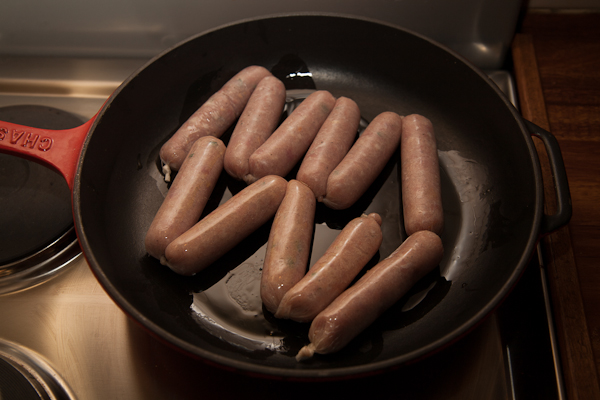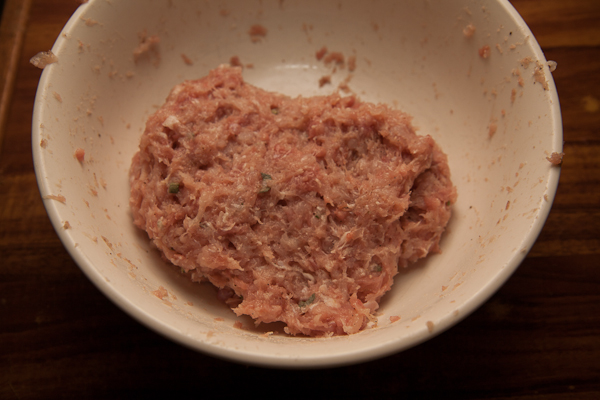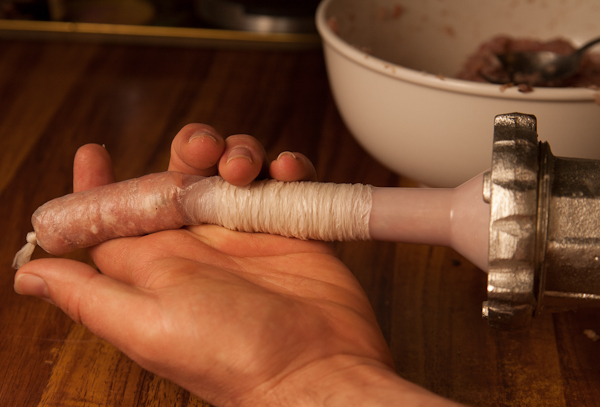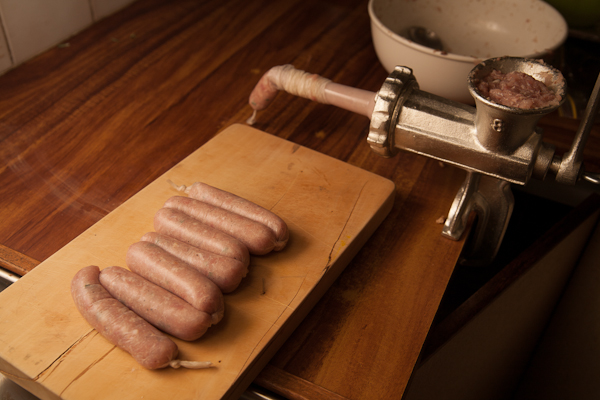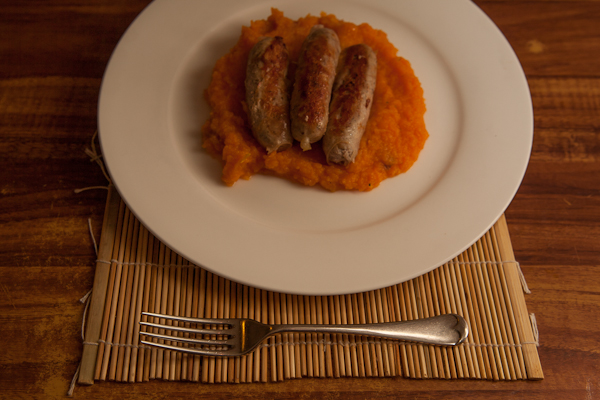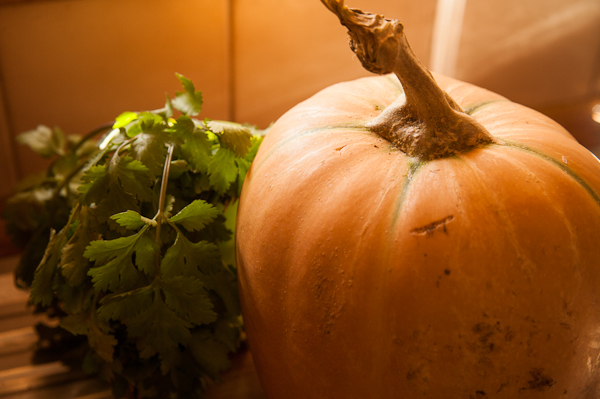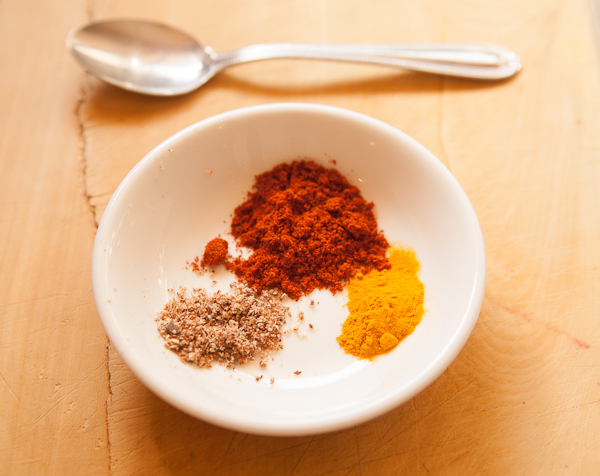It is satisfying to make fresh homemade sausages and I have resolved to make them more often. The whole thing takes less than an hour, and it would be easy to make double the amount and freeze some for later. The best thing is coming up with your own fillings – they can be as crazy or as normal as you like. I have plans for a mega chilli sausage but tonight I did a chicken + fresh herb version. Most recipes call for extra fat for a juicier sausage but if you want a few less calories you can go without – the sausage will be less juicy but still nice.
A few quick tips – Michael Ruhlman in Charcuterie and Paul Bertolli in Cooking By Hand both say a sausage stuffer should be used to fill sausage casings instead of a funnel on a grinder. The problem with the grinder is that chunks of fat can break down too much and then leak out when cooked instead of hanging around to add juicy flavour. This version is the cheapest sausage stuffer on Amazon that gets OK reviews while these ones cost nearly 3 times as much but get much better reviews all round. I’m sold, not that it takes much to make me want a new kitchen gadget, but until I can track one down the old funnel on the mincer is all I have. If using a grinder with funnel, Ruhlman suggests chilling the mince mixture before sending it through the grinder the second time to fill the sausages.
I used to find that fat and sinew got caught on the grinding plate of my grinder, eventually blocking it up and spoiling the texture. It seems like this happens to even the experts sometimes but making sure the die and cutting blade in my grinder were sharp made a big difference. I just rub the flat side of each on a fine diamond stone now and then. Storing the dies and cutter in a zip lock bag with a drop of oil rubbed over stops them from rusting. The other thing that helps is to dice the meat and then pop it in the freezer 30 minutes before starting.
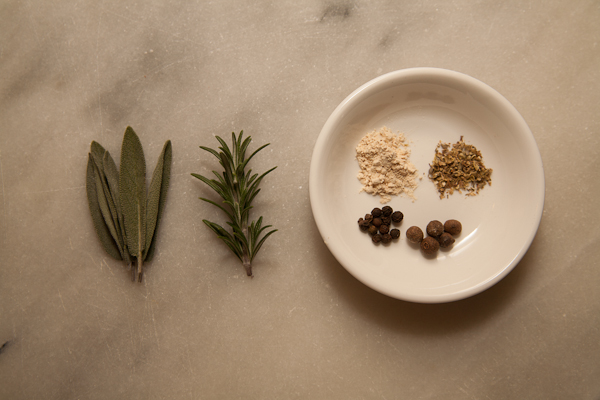
Ingredients
- 750g/1.5lb Chicken thighs
- 4-5 small sage leaves
- 1 small sprig rosemary – about 1 tsp chopped
- 1/2 tsp cracked black pepper
- 1/2 tsp ground allspice (pimento)
- 1 tsp garlic powder
- 1 tsp dried oregano
- 1 generous tsp cooking salt
- Sausage casings – natural casings need to be soaked in water before use, then flushed through with more water. Synthetic casings can be used dry.
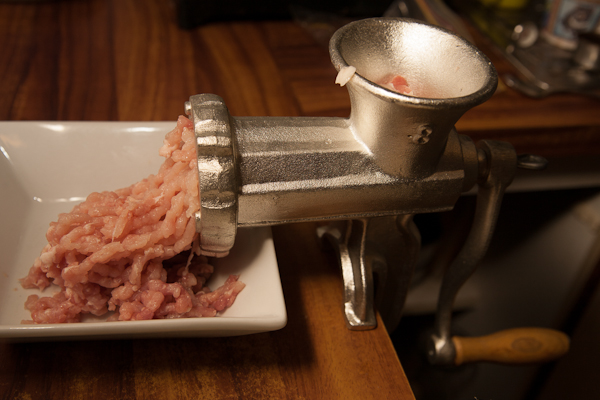
Making The Sausages
1. Chop fresh spices finely. Grind any dry spices that need it.
2. Cut chicken into rough chunks and spread out on a tray. Put it in the freezer about 30 minutes before grinding.
3. Pass chicken through the grinder – I used the finest die. When no more is coming out take half a slice of bread and send it through the grinder to push out the last bits. Stop when the bread starts to come through. It’s surprising how muc more this gets you, at least another sausage worth.
4. Time to get messy: Put the mince in a mixing bowl with all other ingredients and knead until well mixed and the meat feels sticky – a minute or two.
5. When filling I have been using the largest cutting die on my grinder so it doesn’t clog as much. I fit a length of casing over the funnel, working it right down until no more fits and tie a knot in the end.
6. I can just manage this next bit on my own but it’s more fun with an extra person helping – the meat mixture is fed into the grinder or stuffer and cranked or pressed through the funnel. The person on the casing end lets the casing slip off fast enough for the sausage to be plump but not stuffed tight so that it has room to cook.
7. I fill the whole length of the casing before twisting into sausages. When twisting , adjust the pressure in each link so that it isn’t too tight – keep in mind that twisting will make each sausage a bit tighter too. Alternate which way each link is twisted or else they’ll come undone – eg twist clockwise, then anti clockwise in order.

I think sausages are best cooked over a moderate heat so they cook through and get nice and brown without burning. I tried par-cooking before I cut the links so the mix didn’t spill out the ends. Seemed to work.
Bangers and mash are a classic so we ate our sausages with buttery, garlicky pumpkin+sweet potato mash and gravy.
